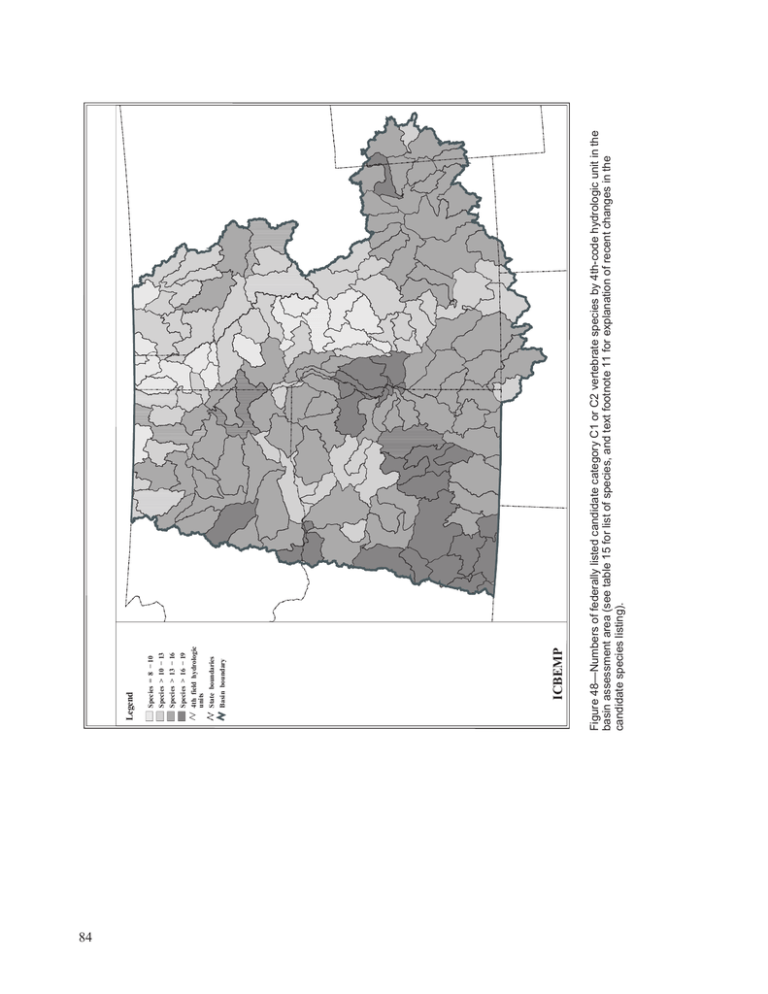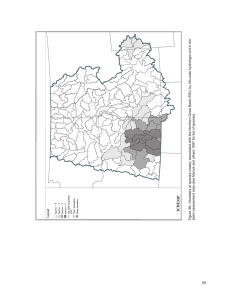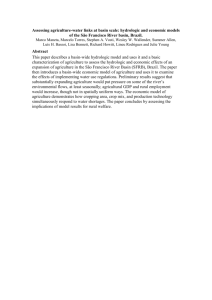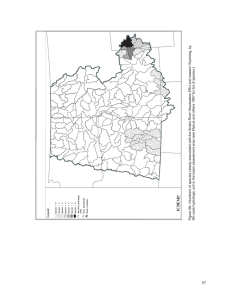the in t uni
advertisement

84 Figure 48—Numbers of federally listed candidate category C1 or C2 vertebrate species by 4th-code hydrologic unit in the basin assessment area (see table 15 for list of species, and text footnote 11 for explanation of recent changes in the candidate species listing). ICBEMP Basin boundary 4th field hydrologic units State boundaries Species > 16 − 19 Species > 10 − 13 Species > 13 − 16 Species = 8 − 10 Legend Although some potential vertebrate habitat corridors could be identified—such as linking Glacier National Park with Yellowstone National Park, or the Blue Mountains and the central Idaho mountains, for many montane or alpine species including mustelids—they did not meet the second criterion for this particular component of being the only locations of associated vertebrate species within the basin assessment area. They are included, however, in the “Full Trophic Ladder Component,” 3(h), discussed below. The following integrity component relates to habitat connectivity as defined above. Component (1d):13 Distribution of species occurring along key habitat corridors—One major habitat corridor that met all the above criteria was found along the eastern spine of the Cascade Range. An assemblage of seven vertebrates14 (table 16) occurs in the basin assessment area only along the spine or eastern flanks of the Cascade Range in Washington and Oregon collectively delineate a mid- to high-elevation montane corridor. The database and map show presence of this corridor by 4th code HUC (fig. 49). The corridor occurs along the eastern flanks of the Cascade Range; additional 4th code HUCs in eastern Washington, northern Idaho, and western Montana also contain disjunct populations of these species and are indicated on the map. 13 This component is numbered out of sequence here to remain consistent with the map index codes on record for ICBEMP. 14 An additional, eighth species fitting these criteria is mountain beaver (Aplodontia rufa), which was not mapped in time for this analysis. Its inclusion would not alter the results, as its distributional range within the basin assessment area matches that of the other species listed for this component. Other vertebrate species such as northwestern salamander, Cope’s giant salamander, ensatina (Ensatina eschscholtzii), Larch Mountain salamander, Columbian black-tailed deer (Odocoileus hemionus columbianus), and others also occur within the basin assessment area only in the Cascade Range, but not broadly along the spine or eastern front. Ecological Integrity Goal 2: Maintain Long-Term Evolutionary Potential of Species The overall concept of maintaining long-term evolutionary potential of species entails, in part, maintaining unique ranges and centers of biodiversity, rarity, and endemism. Species components—The following integrity component relates to distribution of species that may be critical to maintaining long-term evolutionary potential. Other species components to help meet this goal include maintaining unique ecotypes of species, maintaining species at the periphery of their global range, and maintaining unique subspecies, varieties, or phenotypes (Marcot and others 1996). These additional components were not available for mapping in this analysis. Component (2a): Distribution of disjunct vertebrate species populations—Managing for disjunct populations of plants and animals is an important facet of maintaining genetic diversity and longterm evolutionary potential of species (Kruckeberg and Rabinowitz 1985, Millar and Libby 1991). Some 11 vertebrate species are coded in the SER database as having disjunct ranges within the basin assessment area. Two of these species, however, Virginia opossum (Didelphis virginiana) and bullfrog (Rana catesbeiana), are mainly recent invaders or introduced, are not of conservation concern, and are not included in this analysis. In fact, bullfrogs, widely introduced to ponds and lakes throughout the basin assessment area, are predators on some of the more increasingly scarce native amphibians such as red-legged frog. A third species with a disjunct range, pygmy shrew (Sorex hoyi), is largely contiguous within the basin assessment area (as mapped at the broad scale used by the expert panels for this project) with only a small portion of its range disjunct, so it 85 Table 16—Vertebrates that occur within the basin assessment area only along a broad latitudinal extent of the eastern flanks of the Cascade Rangea Species code Scientific name Common name RANCAS Rana cascadae Cascades frog TARGRA Taricha granulosa Rough skinned newt STROCA Strix occidentalis caurina Northern spotted owl SORTRO Sorex trowbridgii Trowbridge’s shrew NEUGIB Neurotrichus gibsii Shrew mole SPESAT Spermophilus saturatus Cascade golden mantled ground squirrel ZAPTRI Zapus trinotatus Pacific jumping mouse a These include species that might benefit by latitudinal habitat corridors of montane and subalpine forests along the eastern slope of the Cascade Range. This list does not include species that enter the basin assessment area from the west only at one point across the spine of the Cascade Range or only up the Columbia River Gorge. Legend Present Absent 4th field hydrologic units State boundaries Basin boundary ICBEMP Figure 49—Occurrence of a habitat corridor for vertebrates of the Cascade Range by 4th-code hydrologic unit in the basin assessment area (see text for further explanation of the extraneous hydrologic units shown shaded here). 86







